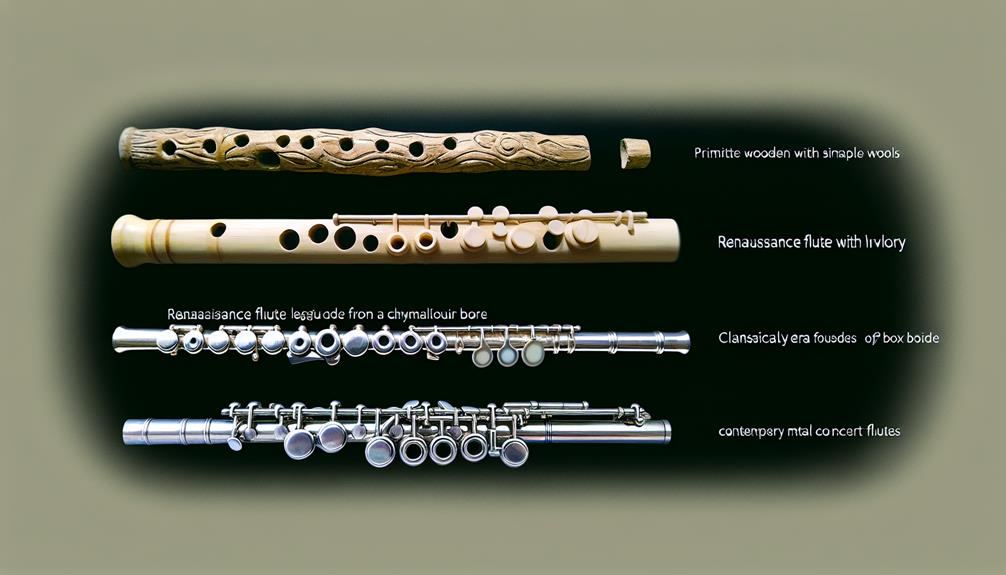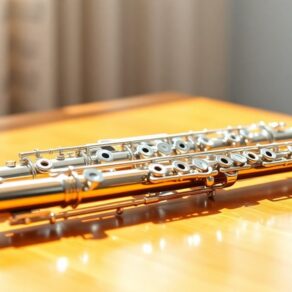When embarking on the journey of selecting the ideal flute that aligns with your skill level, a thoughtful consideration of various factors is paramount. From assessing your proficiency in essential aspects of flute playing to understanding the nuances between materials, key systems, and additional features, the process can be both enlightening and complex. As you navigate the realm of flute selection, the interplay between technical specifications and personal preferences unveils a tapestry of choices awaiting exploration. Stay tuned to unravel the intricacies of finding the perfect flute that resonates with your musical aspirations and skill level.
Key Takeaways
- Assess skill level accurately for appropriate flute selection.
- Consider wood for warm tone, metal for durability.
- Choose closed hole for beginners, open hole for richer sound.
- Decide between inline and offset G key based on comfort.
- Research brands, compare features, consider personal preferences.
Understanding Your Skill Level
When selecting the perfect flute, it is crucial to accurately assess your current skill level in order to find an instrument that aligns with your proficiency. Skill assessment is the foundational step in choosing a flute that will support your musical journey effectively. Understanding where you stand in terms of experience, technique, and musical knowledge is essential to make an informed decision that will enhance your playing experience.
Skill assessment involves evaluating aspects such as your ability to produce different tones, control the airflow, and execute various techniques. It is also important to consider your familiarity with reading music, understanding musical theory, and your overall comfort level while playing the instrument.
Progress tracking is another key element to consider when assessing your skill level. Keeping a record of your development, challenges faced, and milestones achieved can provide valuable insights into your strengths and areas that need improvement.
Material: Wood Vs. Metal Flutes
In the world of flute selection, the choice between wood and metal instruments presents a crucial consideration for aspiring musicians. Each material offers distinct characteristics that can significantly impact the overall playing experience.
Wooden flutes are renowned for their warm and rich tone quality, often favored by experienced players for their ability to produce a more nuanced sound. However, wood flutes require delicate care to maintain their optimal performance and are more susceptible to changes in temperature and humidity, affecting their durability in the long run. Additionally, wooden flutes tend to be lighter in weight compared to metal flutes, making them easier to hold during extended practice sessions. From an aesthetic standpoint, the natural beauty of wood grain can be visually appealing to many musicians.
On the other hand, metal flutes are known for their bright and projecting sound, ideal for performances in large venues or ensembles. These flutes are generally more durable and resistant to environmental factors, making them a reliable choice for musicians who prioritize longevity. The weight of metal flutes can be slightly heavier than wooden flutes, which may affect comfort during prolonged playing sessions. While metal flutes may lack the organic aesthetics of wood, they offer a sleek and modern appearance that appeals to many players.
Ultimately, the decision between wood and metal flutes should be based on personal preferences regarding tone quality, durability, weight, and aesthetics.
Key System: Closed Vs. Open Hole
Comparing the key systems of closed and open hole flutes provides insight into the nuanced differences that can impact a flutist's playing technique and musical capabilities. One key distinction between closed and open hole flutes lies in finger placement and ergonomics. Closed hole flutes have keys that completely cover the holes, making them easier for beginners to play as they require less precision in finger placement. On the other hand, open hole flutes feature holes that are not entirely covered by keys, demanding more accuracy and control from the flutist's fingers. This increased precision in finger placement on open hole flutes can lead to enhanced dexterity and agility over time.
Another significant factor to consider when choosing between closed and open hole flutes is tone quality and resonance. Open hole flutes are known for producing a richer, more resonant sound compared to closed hole flutes. The open holes allow for better venting of the instrument, which can result in improved tone production and projection. Additionally, the ability to partially cover the holes on open hole flutes with the fingertips provides flutists with a unique way to manipulate the tone and color of their sound, offering greater versatility in musical expression.
Ultimately, the decision between closed and open hole flutes should be based on individual preferences, playing style, and long-term musical goals.
Inline Vs. Offset G Key
An essential consideration when selecting a flute is determining whether an inline or offset G key configuration best suits the player's preferences and performance needs. The choice between an inline or offset G key can significantly impact the player's experience in terms of finger placement, ergonomics, tone quality, and embouchure technique.
Inline G keys are aligned with the other keys on the flute, providing a straight and uniform alignment for the fingers. This configuration can be beneficial for players with larger hands or longer fingers as it allows for a more natural hand position. On the other hand, offset G keys are designed to be slightly offset from the main body of the flute, offering a more ergonomic hand position for players with smaller hands or shorter fingers. The offset design can help reduce strain on the hands and wrists during long playing sessions.
In terms of tone quality and embouchure technique, both inline and offset G keys can produce excellent sound when played correctly. However, some players find that the inline G key offers a slightly different feel and response compared to the offset G key. It is recommended for players to try out both configurations to determine which one feels more comfortable and enhances their overall playing experience.
Additional Features to Consider
When evaluating a flute for purchase, it is crucial to consider a range of additional features beyond just the key configuration, in order to ensure that the instrument meets the player's specific needs and preferences. One important aspect to consider is the brand comparison. Different flute manufacturers offer unique qualities in terms of craftsmanship, materials used, and overall reputation within the music industry. Researching and comparing various brands can help you make an informed decision based on your preferences and budget.
Color options are another feature to consider when selecting a flute. While the sound and playability of the instrument are paramount, choosing a flute in a color that resonates with your personal style can enhance your playing experience. Some manufacturers offer a variety of color options, allowing you to select a flute that not only sounds great but also looks aesthetically pleasing to you.
Flute Sizing Guide for Comfort
To ensure optimal comfort and playability while selecting a flute, understanding the appropriate sizing guide is essential for musicians seeking an instrument that fits their physical dimensions effectively. When considering flute sizing, factors such as ergonomics, customization, weight, and balance play crucial roles in determining the most comfortable fit for the player. Here are five key points to consider:
- Ergonomics: Pay attention to the key shape, placement, and reach to ensure that the flute can be comfortably held and played for extended periods without causing strain.
- Customization: Look for flutes that offer adjustable features like key heights, thumb rests, or hand position options to tailor the instrument to your specific comfort needs.
- Weight: Consider the overall weight of the flute, as a heavy instrument may cause fatigue during longer playing sessions, while a too-light flute might lack stability.
- Balance: A well-balanced flute will feel more comfortable to hold and play, with the weight distributed evenly throughout the instrument.
- Try Before You Buy: Always try out different flute sizes and models to find the one that feels most natural and comfortable for your individual physique and playing style.
Budget-Friendly Options for Beginners
For novice musicians looking to start their flute playing journey without breaking the bank, there are several cost-effective options available that provide quality sound and playability. Beginners can take advantage of online resources and tutorials to learn the basics of playing the flute. Additionally, attending local workshops or classes can provide valuable hands-on experience and guidance from experienced instructors.
To help you navigate the budget-friendly flute options, below is a comparison table highlighting some popular choices for beginners:
| Brand | Model | Key Features | Price Range |
|---|---|---|---|
| Yamaha | YFL-222 | Reliable, easy to play, durable | $300 – $500 |
| Gemeinhardt | 1SP | Lightweight, responsive, good tone | $200 – $400 |
| Mendini | MFE-22 | Affordable, comes with accessories | $100 – $200 |
| Jean Paul | FL-220 | Sleek design, good for beginners | $150 – $250 |
These options cater to different preferences and budgets while ensuring a solid foundation for beginners. Investing time in online resources and attending local workshops can complement the choice of a budget-friendly flute, enabling a smoother learning experience. By combining these resources with a suitable flute, beginners can kickstart their musical journey without compromising on quality.
Upgrading Your Flute as You Progress
As beginners advance in their flute playing skills, considering an upgrade to a higher-quality instrument becomes a natural progression to further enhance their musical development. Investing in a better flute not only improves the sound quality but also offers advanced features that can support the player in developing their skills further.
Here are some key aspects to consider when upgrading your flute:
- Improved Sound Quality: A higher-quality flute will typically produce a richer and more resonant sound, enhancing your overall performance.
- Enhanced Durability: Upgrading to a better flute often means a more durable instrument that can withstand rigorous practice sessions and performances.
- Advanced Mechanisms: Higher-quality flutes come with advanced key mechanisms that allow for smoother playing and more intricate techniques.
- Customization Options: Some upgraded flutes offer customization options, allowing you to tailor the instrument to your specific preferences and playing style.
- Compatibility with Flute Accessories: Upgrading your flute may open up opportunities to explore a wider range of flute accessories that can further enhance your playing experience.
When considering an upgrade, it is crucial to also focus on maintaining your flute regularly to ensure its longevity and optimal performance. Proper care, regular cleaning, and maintenance routines will help preserve the quality of your instrument and support your musical journey as you continue to refine your flute embouchure and technique.
Maintenance Tips for Longevity
Regular maintenance is imperative for ensuring the longevity and optimal performance of your flute. To keep your instrument in top condition, it is essential to follow proper cleaning techniques. After each use, gently swab the inside of the flute with a cleaning rod and cloth to remove moisture and prevent the buildup of dirt and bacteria. Additionally, wipe down the exterior of the flute with a soft, dry cloth to maintain its shine and prevent tarnishing.
When not in use, proper storage is key to protecting your flute. Store it in a hard case to shield it from dust, moisture, and accidental damage. Ensure that the flute is placed securely in the case to prevent any movements that could cause misalignments or dents.
In addition to regular cleaning and proper storage, preventative maintenance is crucial for avoiding costly repairs. Schedule routine check-ups with a qualified technician to inspect the flute for any signs of wear and tear. Addressing minor issues promptly can prevent them from escalating into major problems that may require expensive repairs.
Trying Before You Buy: Expert Advice
When seeking the perfect flute, expert guidance on trying before you buy is essential for making an informed decision that aligns with your musical aspirations and technical requirements. Before committing to a purchase, consider the following expert advice:
- Trial Period: Look for shops or online platforms that offer a trial period for flutes. This allows you to test the instrument in different settings to ensure it meets your needs.
- Rental Options: Some music stores provide rental options for flutes, enabling you to play the instrument for an extended period before deciding on a purchase.
- Virtual Demos: Explore virtual demos offered by flute manufacturers or music stores. These demos can give you a detailed look at the flute's features and sound quality.
- Online Resources: Utilize online resources such as forums, reviews, and videos to gather information about different flute models and brands. This can help you narrow down your choices before trying them out.
- Expert Consultation: Seek guidance from experienced flute players or music instructors. Their insights can provide valuable information on selecting a flute that suits your skill level and playing style.
Frequently Asked Questions
Can I Switch From a Closed Hole Flute to an Open Hole Flute Later On?
Transitioning from a closed hole flute to an open hole flute is possible with certain modifications. While it may pose initial challenges due to the change in finger placement, it can enhance your skill progression.
Consider seeking guidance from a music instructor to ease the transition. Ultimately, the decision to switch should align with your musical goals and willingness to adapt to the adjustments required for playing an open hole flute effectively.
Are There Flutes Specifically Designed for Outdoor Performances?
Flutes designed for outdoor performances often feature customized options to enhance durability and weather resistance. These instruments prioritize sound projection to ensure clarity in open-air settings.
Manufacturers offer a range of models tailored for outdoor use, incorporating materials and design elements that can withstand varying environmental conditions.
When selecting a flute for outdoor performances, it is essential to consider these factors to optimize the instrument's performance and longevity in outdoor settings.
What Is the Impact of Altitude on Flute Performance?
Altitude effects on flute performance can be significant, as the change in air pressure can alter the instrument's pitch and response. To mitigate these impacts, flutists should consider adjusting their embouchure and breath support.
Additionally, ensuring proper maintenance of the flute, such as regulating key mechanisms and pad seals, becomes crucial at varying altitudes. These maintenance tips can help maintain the instrument's optimal performance and playability under different atmospheric conditions.
How Does the Flute Material Affect Tone Quality?
The choice of flute material, whether metal or wood, significantly impacts tone quality. Metal flutes generally produce a brighter, sharper sound, while wooden flutes offer a warmer, more mellow tone.
Additionally, the maintenance requirements differ between the two materials. Metal flutes are more resistant to changes in humidity and temperature but require regular polishing. On the other hand, wooden flutes need careful handling and occasional oiling to maintain their optimal performance and tone quality.
Are There Specific Flutes for Different Genres of Music?
Flute construction plays a pivotal role in genre versatility. Various flutes are designed with specific features to cater to different musical genres.
For instance, a flute with a silver headjoint might offer a brighter tone suitable for classical music, while a flute with a gold-plated headjoint may provide a warmer sound preferred in jazz or contemporary genres.
Understanding how flute construction influences tone can help musicians select the perfect instrument for their preferred musical style.
Conclusion
In conclusion, selecting the perfect flute for your skill level requires a thorough understanding of key factors such as material, key system, and additional features. It is essential to consider expert advice and try out different options before making a decision.
An interesting statistic to note is that according to a survey conducted by the National Flute Association, 85% of flute players reported feeling more confident and motivated to practice when they had the right instrument for their skill level.




